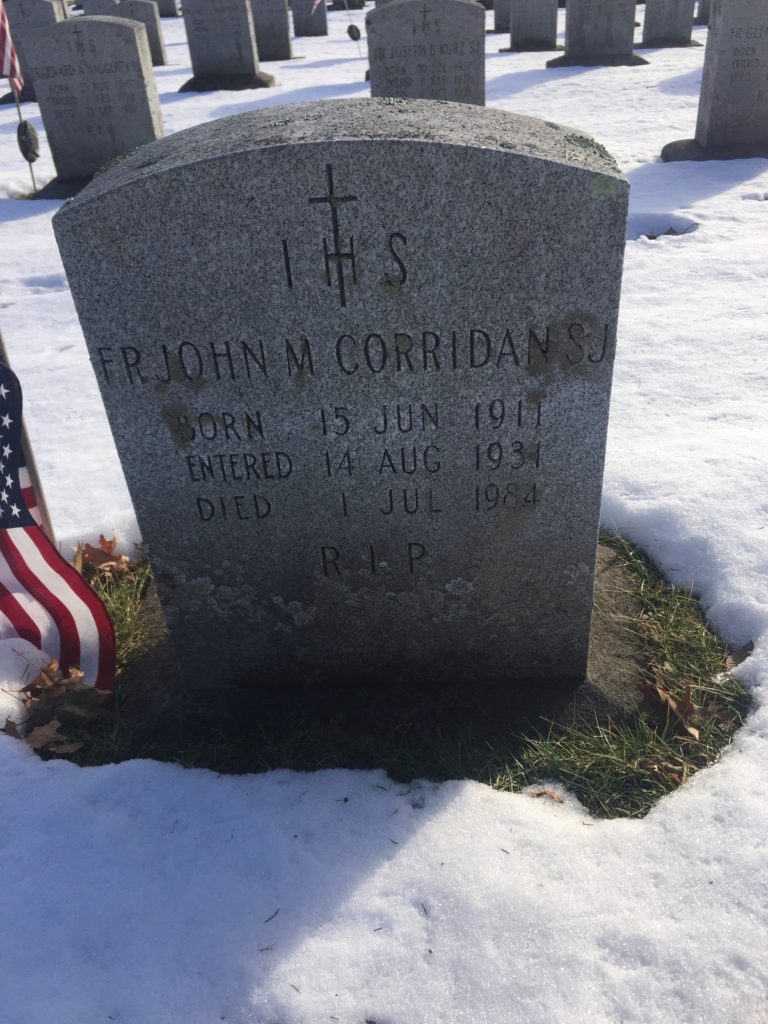Erik Visits an American Grave, Part 686
This is the grave of John Corridan.

Born in 1911 in Harlem, Corridan grew up poor. His father was an Irish-American cop, but he died shortly after John was born. The family had almost nothing. He graduated from high school in 1928 and went to Wall Street, where he worked through the early years of the Great Depression, managing to hold onto his job in these dark years. But in 1931, he joined the priesthood, eventually getting a master’s degree in economics as well. As a priest, he was highly interested in labor issues, fighting for a fair shake for working people. This was part of the Catholic Church’s attempt to influence moderate unionism in these years. The Church was really pretty good on labor issues in many cases, so long as those unions were anti-communists. But toward the communists, there was no quarter. So creating moderate unionism with influence from smart worker-friendly priests was an intentional process. Corridan became one of the most important figured in this.
But in New York, communism was often not the biggest problem workers faced, if it was really a problem at all. The bigger issue often was that some of the unions were mob-run and thus actually anti-worker, cutting sweetheart deals and contributing to the exploitation of workers. This was true of the International Longshoremen’s Association, which was about as opposite from the ILWU on the west coast run by the great Harry Bridges as one could be. This was a quite corrupt union with mob bosses running it. Corridan was outraged by this and got involved in the reform movements to oust the mafia from unions. He worked in the Xavier Institute of Industrial Relations, the Jesuits’ New York labor training school, beginning in 1946. Because he came from the same background as the workers on the docks, he was not only sympathetic with their plight but could talk to them in ways that most other priests could not. He then worked with the journalist Malcolm Johnson to expose the mafia running of the ILA.
In short, if you haven’t figured this out yet, Corridan was the inspiration for Father Barry in Elia Kazan’s 1954 classic On the Waterfront. Played by the great Karl Malden, it’s the soul of the movie. And while we can criticize the film for being Kazan’s whiny response for naming names to the House Un-American Activities Committee, the performances are impeccable. Corridan was then the subject of a 1955 biography on his work on the waterfront. That worked helped in the creation of the New York-New Jersey Waterfront Commission to get rid of the mob on the docks and in the ILA. Over time, this had a big impact, but less so than the automation that simply got rid of most of the jobs on the docks and weakened the unions. He never was able to get the rank-and-file workers in the ILA to take on the corrupt leadership.
In 1957, Corridan decided it was time for a new assignment. He took a job at Le Moyne College in Syracuse, where he taught economics to a new generation of Catholic students. He would later teach theology at Saint Peter’s College in New Jersey and worked as a hospital chaplain in Brooklyn. He died of a heart attack in 1984, at the age of 73.
John Corridan is buried in Jesuit Cemetery, Auriesville, New York.
This grave visit was supported by LGM readers. Thanks again for keeping this series alive! If you would like this series to visit other American Catholics, you can donate to cover the required expenses here. Mother Angelica, famous for her television appearances on Catholic TV, is in Hanceville, Alabama, and Dorothy Day is in Staten Island. Previous posts in this series are archived here.


